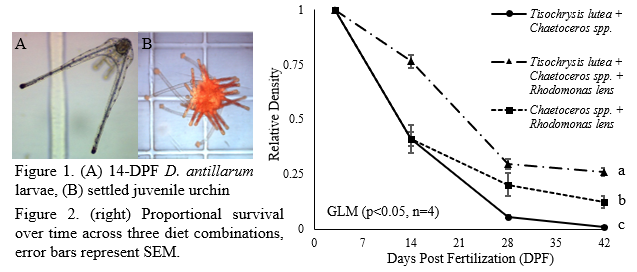DEVELOPMENT OF LARVICULTURE PROTOCOLS FOR REARING THE ECOLOGICALLY IMPORTANT LONG-SPINED SEA URCHIN Diadema antillarum WITHIN A NOVEL RECIRCULATING SYSTEM
The long-spined sea urchin (Diadema antillarum) was once an abundant reef-grazing herbivore throughout the tropical western Atlantic. In 1983-1984, an unidentified disease affecting D. antillarum caused 93-100% mortality on Caribbean coral reef populations. This event resulted in a sudden lack of herbivory and contributed to ecological phase shifts from hard coral dominated to macroalgae dominated reef systems. Recovery has been slow or nonexistent and attempts to restore resilient coral reefs at scale would benefit from augmenting herbivory via establishment of sexually propagated D. antillarum. A critical first step in this direction is the ability to reliably produce this species from gametes. However, a difficult and lengthy larviculture (Fig. 1A) period of ~40 has resulted in inconsistent success over the past 30 years.
The purpose of this study was to develop protocols for rearing D. antillarum within a novel 1800 -L recirculating aquaculture system (RAS). An initial trial examining the effects of microalgae diet (Tisochrysis lutea and Chaetoceros spp.) densities on larvae stocked at 4 ml-1 in 40-L replicate tanks resulted in similar growth and survival between high density (40k cells ml-1, n=5) and low density (10k cells ml-1, n=5) treatments at 21 days post fertilization (DPF). The high-density treatment resulted in 6.6% growth per day and was used to establish a reference diet for subsequent trials. Further experimentation examined the effects of carbon-equivalent microalgae diet combinations on growth and survival. In two separate experiments, diets containing Rhodomonas lens outperformed the reference diet at 21-DPF and 42-DPF (Fig. 2). Data generated within the RAS were used to establish fundamental larviculture protocols that have since produced juvenile D. antillarum (Fig. 1B). Current efforts are focused on improving yields to achieve restoration relevant scale.
